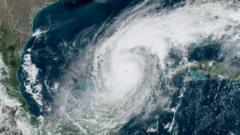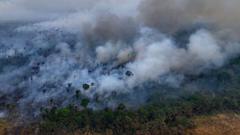A recent study emphasizes that higher temperatures create a "thirstier" atmosphere, which significantly contributes to more severe and widespread drought conditions across various regions. Farmers are struggling to meet crops' water demands amidst these changes, calling for urgent attention to agricultural practices.**
Addressing the Thirst: How Climate Change Intensifies Droughts**

Addressing the Thirst: How Climate Change Intensifies Droughts**
New research highlights that climate-driven temperature increases are exacerbating droughts through enhanced evaporation rates.**
As drought conditions become increasingly concerning globally, researchers are unveiling crucial insights into the dynamics at play. A study from a team led by hydroclimatologist Solomon Gebrechorkos at the University of Oxford reveals that rising temperatures, a direct consequence of climate change, are creating an atmosphere that accelerates evaporation—a phenomenon termed "atmospheric thirst." This has not only intensified droughts but has also increased their frequency and geographical impact over the last four decades.
The interplay between precipitation and evaporation has long been a fundamental aspect of drought studies, but this new research highlights a critical gap: the balance between water supply and demand is significantly affected by atmospheric conditions. In essence, as the Earth warms, it becomes more capable of pulling moisture from the environment, which can lead to faster drying of soils, a challenge that agricultural producers are grappling with.
Meetpal Kukal, an agricultural hydrologist at the University of Idaho, underscores the urgency of the situation. Older irrigation systems, like those using center-pivot sprinklers established two decades ago, are proving insufficient in meeting actual crop water requirements under current climatic stressors. Farmers are witnessing rapid soil drying, often before adequate irrigation can replenish moisture levels, putting their yields at risk.
Dr. Gebrechorkos argues for a paradigm shift in how we study and approach drought. Traditionally, research has been skewed toward understanding rainfall patterns, often neglecting the equally critical aspect of atmospheric water loss. Such a narrow focus is akin to managing finances by only considering income while ignoring outlays; a misleading approach that could lead to disastrous consequences.
As farmers and researchers alike seek to adapt to these new realities, it is clear that addressing the multifaceted challenges of drought in a warming world requires a comprehensive understanding of both supply and demand. The time for policy and innovative agricultural measures is now, as the thirst of the atmosphere continues to grow.



















